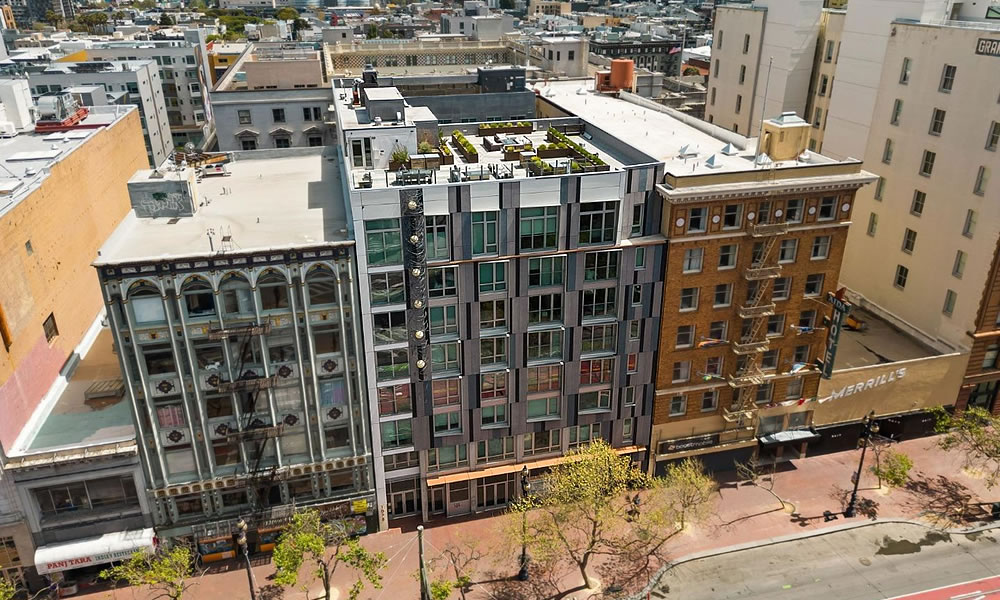As we outlined in November of last year, the two-bedroom, two-bath, two-parking space unit #513 in the boutique Mid-Market building at 1075 Market Street (a.k.a. Stage 1075) had just been reduced to $769,000, a sale at which would have represented a net 38 percent drop in value for the 870-square-foot unit from the second quarter of 2019, at which point it had traded for $1,250,000 and established a neighborhood and building comp at $1,437 per square foot.
Further reduced to $695,000 and listed anew with an official “1 day on the market” two months ago, the contemporary condo, which “checks all the boxes,” on a high floor, “in the pulsating center of San Francisco,” is once again inventory, having been briefly in contract last week, an “at asking” sale at which would represent a 44.4 percent drop in value for the two-bedroom condo on an apples-to-apples basis, despite some misreports of a market rebound or “pivot.”.
Once again, if you think you know the market for contemporary Mid-Market condos and other units which benefited from the 2019-era comp(s), here’s another chance to tell.







Ahh yes, Market Street in between 6th and 7th, the epicenter of San Francisco. Really showing off the city at it’s finest…
Maybe plopping boutique projects on skid row (aka “gentrification,” aka “class war,” aka “massive upward transfer of wealth”) was just a Ponzi gimmick after all?
Right, going from a boarded up strip club to 90 units of housing, which brings in ~$900K of tax revenue to the city every year, along temporary and ongoing working class jobs (security, maintenance), and ~120 new residents who buy things nearby is a real step in the wrong direction. Totally agree.
Addressing extreme economic inequality by displacing the have-nots, and by increasing the shelter costs of the have-nots who manage to dodge displacement, does not actually solve extreme economic inquality, but it does have the upside of transferring even more wealth to the already wealthy, further exacerbating economic inquality. This is objectionable to those who see extreme economic inequaliy as both a moral and imperative social problem, as opposed to those who use the cover of addressing extreme economic inequaliy as a means to augment their own wealth.
“ongoing working class jobs (security, maintenance)”
lol. “Miss your well-paid PDR job? Quit yer bawling, here, have a mop!”
Whom did this project displace?
Adding 11 below-market-rate (BMR) units to a lot which previously had zero (0) below-market-rate units is a good thing for the have-nots. So are all of the temporary and permanent jobs created by this. So is the $900K of annual tax revenue which goes to pay MUNI workers, or perhaps the $1.2B in non-profit donations the city makes every year to those in need. We need to keep doing this over and over and over again. I’m so happy Stage 1075 exists!
The myth that the city needs, impossibly, an endless series of new, high-priced properties to tax in order to pay for the social services necessitated by the gentrification induced by those same new, high-priced properties plays well for the gentrification-speculation industry, but whenever the city’s coffers grow, how much goes to social services and how much goes to billion-dollar infrastructure boondoggles designed to further augment gentrification and property values?
And sometimes the anticipated tax revenue never materializes or winds up having to support some other project. Case in point: the 50 First Street project that was announced with great fanfare and supposed to break ground in Nov of 2016.
Well, here we are, more than seven years later and, according to the story from yesterday’s S.F. Standard bylined by Kevin Truong, “today, the project site is nothing more than a literal money pit of concrete and metal in the heart of downtown, filled with a tangled thicket of lawsuits and pointed fingers…taking over the site will be an expensive proposition. According to city tax records, the owners have failed to pay property taxes for the site since 2020 and currently owe nearly $13 million.”
If what happened in the Los Angeles project that the same developer (a publicly traded Beijing-based company that halted the project in 2019 when it ran out of money) abandoned mid-construction is any indication — on that site, the Los Angeles City Council wound up being forced to allot nearly $4 million to remove graffiti and secure unfinished downtown Los Angeles skyscrapers that had been heavily tagged — S.F. could be spending tax money generating from several other projects like Stage 1075 on winding down uncompleted luxury projects that were previously earmarked for social services in the coming years. Starting in FY 2025, The City is projecting a budget shortfall of approximately $799 million with a $245 million deficit in the first year and $554 million in the second year.
this would be a great location to provide police housing.
That might be more of a hindrance than benefit for police recruitment.
The area is definitely “pulsating” with activity, just not the kind you want outside your door! A for effort for the realtor copy.
More twitching than pulsating, but also “yes”.
“checks all the boxes” – i wonder which boxes they are referring to. the only “box” i can think of is it has parking.
$1000/month HOAs. Enough said.
The security guy with the flamethrower is expensive.
And why, at the initial price level with designer cabinets and appliances, did the developer install baseboard heating in the units instead of heat pumps that could provide heating and cooling in a densely constructed location?
Was the expectation that the climate would become so cool that people would not need to open their windows, or that the streets would become so quiet that people could sleep with their windows open in warm weather?
Because this building, like other similar ones, was built to sell to a demographic of rich-but-not-savvy techies who would not recognize those deficiencies until after the ink had dried on the purchase contract.
And this phenomenon is captured by the phrase, when used in the context of the S.F. real estate “game”, value engineering.
UPDATE: Mid-Market Two-Bedroom Resells for Nearly 50 Percent Less